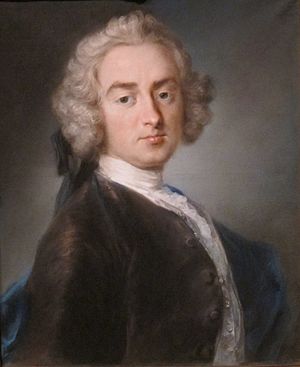Sir James Gray, 2nd Baronet facts for kids
Quick facts for kids
Sir James Gray
|
|
|---|---|

Sir James Gray, Second Baronet by Rosalba Carriera, Getty Center
|
|
| Born | c. 1708 |
| Died | 14 February 1773 |
| Nationality | British |
| Alma mater | Clare College, Cambridge |
| Occupation | diplomat; antiquary |
Sir James Gray, 2nd Baronet (born around 1708 – died February 14, 1773) was an important British diplomat and a keen collector of ancient artifacts, also known as an antiquary. A diplomat is someone who represents their country in other nations, working to keep peace and good relationships. An antiquary is a person who studies and collects old things, like ancient ruins or historical objects.
Contents
Early Life and Education
James Gray was the older son of Sir James Gray, 1st Baronet. His younger brother was General George Gray. James studied at Clare College, Cambridge, where he earned his Master of Arts degree in 1729. After finishing his studies, he traveled around Europe.
Diplomatic Career
Sir James Gray began his career as a diplomat in 1744. He started as a secretary in Venice, Italy. From 1746 to 1752, he became the main representative for Britain in Venice.
In October 1753, he moved to Naples, which was then a kingdom in Italy. He stayed there until 1763. During his time in Naples, he went on a special mission to Rome in 1755. This mission was about The Young Pretender, a person who claimed to be the rightful king of Britain.
His last job as a diplomat was serving as the British ambassador to Spain. He held this position from 1766 to 1770. When he returned to England in 1769, he became a member of the Privy Council. This is a group of important advisors to the King or Queen. In 1759, he was also honored as a Knight Companion of the Order of the Bath.
Interests and Discoveries
Sir James Gray and his brother George were among the first members of a group called the Society of Dilettanti. This society was for people who loved art and ancient history. George Gray was even the secretary and treasurer for the group.
While Sir James was in Naples, he became very interested in the archaeological discoveries happening nearby. People were finding amazing ancient ruins at places like Portici and Herculaneum. He helped young travelers on their "Grand Tour" of Europe. The Grand Tour was a traditional trip taken by young, wealthy Europeans to learn about art and culture. Sir James would suggest suitable young people to join the Society of Dilettanti. He also gave advice about the king's new palace being built at Caserta.
Later Life and Family
Sir James Gray passed away in 1773. He had a son named James, born in 1759, and a daughter named Catherine, born in 1761. They were both born in Naples. After his death, his title of Baronet was passed to his brother, George. However, George also died in the same year, and so the title ended.
Sources
- L. H. Cust, ‘Gray, Sir James, second baronet (c.1708–1773)’, rev. S. J. Skedd, Oxford Dictionary of National Biography, (Oxford University Press, 2004; online edn, Jan 2008), Retrieved 26 Aug 2008

